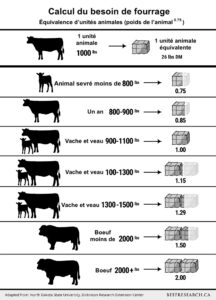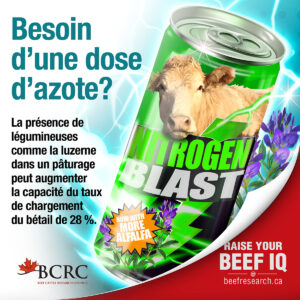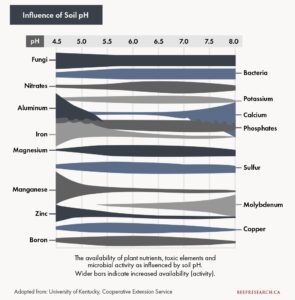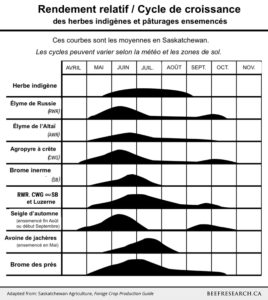Au revoir à l'ancienne, bienvenue à la nouvelle 🎙️
CLIQUEZ SUR LE BOUTON « PLAY » POUR ÉCOUTER CET ÉPISODE (article offert en anglais seulement):
Écoutez d’autres épisodes sur BeefResearch.ca, Spotify, Apple Podcasts, Amazon Music ou Podbean.
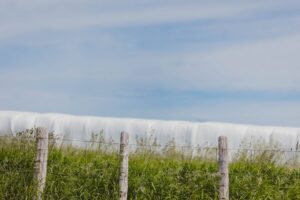
De nouvelles variétés de fourrage contribuent à combler les lacunes de la saison de pâturage en permettant aux bovins de boucherie de paître plus longtemps chaque année, en améliorant la qualité du fourrage dans des zones de croissance auparavant médiocres et en fournissant des aliments d’hiver de haute qualité.
Étant donné que les pâturages, le foin et l’ensilage de cultures fourragères vivaces et annuelles fournissent la majeure partie de l’alimentation annuelle des bovins de boucherie, les producteurs doivent avoir accès à des variétés à haut rendement, de haute qualité et bien adaptées afin d’améliorer les aspects économiques de la production. Cependant, il peut être difficile de savoir quelle variété de fourrage répondra aux besoins de chaque exploitation et de chaque scénario d’alimentation. Il peut sembler plus facile de s’en tenir à la variété fourragère que l’on connaît et que l’on sème depuis des années, mais passe-t-on à côté des avantages que peuvent apporter les nouvelles variétés fourragères ?
Quels sont les avantages potentiels des nouvelles variétés de fourrage ?
Rendement plus élevé
Les nouvelles variétés sont souvent développées pour produire davantage de fourrage de meilleure qualité que les variétés traditionnelles.
La quantité de fourrage produite détermine directement la production animale par acre. Par exemple, l’augmentation de la production de fourrage sur les parcours ou les pâturages signifie que des taux de chargement plus élevés peuvent être appliqués et que les performances des animaux peuvent également être améliorées. De même, l’augmentation des rendements des prairies de fauche ou des cultures annuelles ensemencées pour la production de fourrage accroît la matière sèche (MS) récoltée et stockée du fourrage, et réduit le coût par unité de production. Cela se traduit par une réduction des coûts d’aliments pour animaux pour l’hiver par vache.
Une meilleure qualité
On pense souvent à la quantité lorsqu’il s’agit de nourrir les bovins de boucherie, mais c’est la qualité qui compte vraiment. La qualité du fourrage est définie par sa valeur nutritive ou, en d’autres termes, par la quantité disponible d’énergie, de protéines, de fibres, de minéraux et de vitamines que le fourrage fournit lorsqu’il est consommé par le bétail. Cette concentration de nutriments a un impact direct sur les performances (santé et croissance) de chaque animal.
La qualité avant la quantité
La concentration en nutriments (qualité) d’un fourrage a un impact direct sur les performances (santé et croissance) de chaque animal.
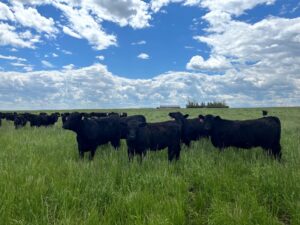
Les différents composants d’une plante, tels que les fibres, les protéines et les hydrates de carbone, ont un impact différent sur la qualité du fourrage. Par exemple, la lignine, qui est un composant structurel des parois cellulaires des plantes, limite la digestion microbienne dans le rumen, ce qui a un impact négatif sur la digestibilité de ce fourrage. Des concentrations accrues de lignine dans la culture fourragère en croissance augmenteront le pourcentage de MS fourragère non digestible pendant le pacage ou au moment de la récolte. Ces fourrages de moindre qualité (plus de fibres, moins de digestibilité) peuvent réduire l’ingestion globale de fourrage, ce qui compromet les performances des animaux. Le choix d’une variété de fourrage à faible teneur en lignine (de meilleure qualité) à inclure dans votre rotation peut contribuer à réduire ce problème.
Amélioration de la sapidité
La sapidité d’un fourrage est la combinaison des caractéristiques ou des conditions de la plante qui encouragent le bétail à la consommer. Les facteurs qui influencent la sapidité sont la texture, l’arôme, le pourcentage de feuilles et la teneur en sucre. Une meilleure sapidité signifie essentiellement que les animaux aiment manger ce fourrage.
Dans les systèmes de production extensive, l’apport en fourrage fournit l’énergie nécessaire à la santé et à la production optimales des bovins (p. ex. croissance, production de lait, reproduction). Cela signifie que la sapidité devient extrêmement importante, car la volonté d’un animal de manger un fourrage aura un impact direct sur ses performances – plus la plante est agréable à manger, plus l’animal en consommera.
L’une des façons dont les nouvelles variétés offrent une meilleure sapidité est d’augmenter le rapport entre les feuilles et la tige. Les feuilles sont beaucoup plus agréables à manger et de meilleure qualité que la tige de la plante. Par conséquent, l’augmentation du nombre de feuilles par plante favorise des niveaux d’ingestion plus élevés.
La sapidité est extrêmement importante, car la volonté d’un animal de manger un fourrage aura un impact direct sur ses performances – plus la plante est agréable à manger, plus l’animal en consommera.
Réduction des coûts d’engrais
L’objectif de la fertilisation des cultures fourragères est de réduire le coût unitaire de production. Cependant, des rendements plus élevés ne se traduisent pas nécessairement par une baisse des coûts ou une augmentation des bénéfices. Ce n’est que lorsque la valeur du fourrage supplémentaire produit est supérieure au coût de l’application que le coût unitaire de production est réduit et que les marges augmentent. Par conséquent, la rentabilité de la fertilisation des cultures fourragères est très variable et dépend du coût de l’engrais, des prix du foin et des conditions météorologiques et du sol dans la région.
Sélectionner la bonne variété de fourrage peut contribuer à réduire les besoins en engrais grâce au développement de variétés qui fixent plus efficacement l’azote, qui produisent davantage de biomasse par unité d’azote ou qui sont plus tolérantes à la sécheresse.
Meilleure résistance aux maladies et aux ravageurs
Les maladies et les insectes peuvent avoir des effets négatifs importants sur le rendement, la qualité, l’utilisation par le bétail et la longévité d’un peuplement fourrager. Il est essentiel de minimiser ces pertes pour maintenir ou augmenter la productivité.
Certaines variétés de légumineuses et de graminées ont été développées pour résister aux insectes et aux maladies qui affectent les plantes fourragères. Choisir ces variétés peut contribuer à réduire la quantité de traitements antiparasitaires utilisés dans la culture fourragère.
Une meilleure adaptation aux conditions régionales
De nombreuses régions du Canada connaissent des conditions météorologiques imprévisibles, y compris des sécheresses, de graves inondations et des hivers difficiles. En outre, certaines régions peuvent avoir des sols acides, un mauvais drainage ou une concurrence extrême des mauvaises herbes. Ces conditions peuvent entraîner une diminution des rendements fourragers, une baisse de la qualité et une mauvaise persistance des peuplements, limitant la quantité de fourrage disponible pour la consommation par le bétail.
Choisir un fourrage adapté aux conditions du site d’ensemencement peut s’avérer plus efficace que d’adapter le site à un fourrage attrayant. Certaines nouvelles variétés de fourrage offrent un avantage à cet égard. Par exemple, les variétés résistantes à la chaleur peuvent prolonger la saison de pâturage pendant les mois d’été. De même, les variétés présentant une résistance accrue au stress de sécheresse sont essentielles pour maintenir la qualité du pâturage pendant les périodes de sécheresse.
Comment sélectionner de nouvelles variétés de fourrage
Voici des facteurs clés à prendre en compte lorsqu’on choisit une variété de fourrage :
- Les conditions climatiques régionales (p. ex. inondations, précipitations, durée de la période de croissance).
- L’utilisation prévue du fourrage (p. ex. récolte d’aliments pour animaux, pacage)
- Les conditions du sol (p. ex. la teneur en éléments nutritifs, le pH)
- Gestion du pâturage (par exemple, pâturage en rotation, pâturage prolongé)
- Besoins des bovins (p. ex. veaux par rapport aux vaches adultes)
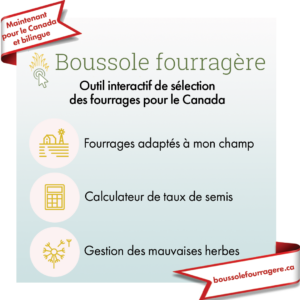
Pensez à contacter des experts en vulgarisation locaux ou des agronomes de votre région pour obtenir des informations sur les variétés de fourrage adaptées à votre région.
Il est également utile de consulter les voisins pour savoir ce qu’ils font et ce qui a fonctionné dans leurs exploitations.
Des outils en ligne, comme Boussole fourragère, peuvent aider les agriculteurs et les éleveurs allant de la Colombie-Britannique aux Maritimes à choisir les plantes fourragères les mieux adaptées à leurs champs, à calculer les taux de semis et à lutter contre les mauvaises herbes dans les fourrages.
Le partage ou la réimpression des publications du BCRC sont les bienvenus et sont encouragés. Veuillez mentionner le Beef Cattle Research Council, fournir l’adresse du site Web, www.BeefResearch.ca, et nous faire savoir que vous avez choisi de partager l’article en nous envoyant un courriel à info@beefresearch.ca.
Vos questions, commentaires et suggestions sont les bienvenus. Contactez-nous directement ou lancez une discussion publique en publiant vos idées ci-dessous.
